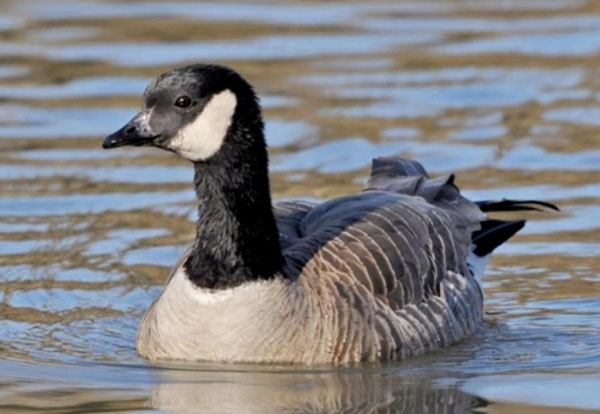Branta hutchinsii
IUCN
LCBasic Information
Scientific classification
- name:Branta hutchinsii
- Scientific Name:Branta hutchinsii,Cackling Goose,Small Canada goose, short bill Brant
- Outline:Waterfowl
- Family:Aneniformes Anatidae Brancus
Vital signs
- length:76cm
- Weight:950-3000g
- lifetime:13years
Feature
It is very similar to the Canadian bracken, with a shorter beak and much shorter neck.
Distribution and Habitat
Chinese lost birds are seen in Dongting Lake. Foreign breeding occurs in the Aleutian Islands, Alaska and northern Canada and Greenland, wintering from southern North America to Mexico, and occasionally in Japan.
They live in grassy rivers, lakes and swamps, and live in non-breeding colonies on farmland, reservoirs, lakes and wide rivers, mixing with other large geese.
Appearance
The head and neck are black with white patches forming a "white mustache" from the back cheek to the throat, sometimes with white rings at the base of the neck, the body feathers are grayish brown with white and brown stripes, the tail feathers are dark brown, and the buttocks and undertail are white. Iris dark brown, beak black, feet black.
Details
The Lesser American Brant is a North American black goose of the genus Brant of the family Anatidae that breeds in northern and central Canada and Alaska. During migration and during wintering, young brants exhibit social behavior. At this time, individuals and families will mix with the Canadian barnacle to form a sizable population. As the breeding season approaches, the geese don't flock together as much, and pairs of young barns leave the pack in search of nesting sites.

The little American Bracken is a long-distance migrant. To reach their wintering grounds in California, the Gulf of Mexico and Mexico, they find a fairly direct flight shortcut from their nesting grounds. Autumn migration to the south occurs at the end of August and is usually not stopped or interrupted. The spring migration begins at the end of January and is marked by many stops along the way to feed and refuel before reaching your destination. Migratory groups consist of families and isolated individuals. Groups vary in size depending on the subspecies. When flying, a "V" shaped echelon is used, usually staying at a low altitude between 300 and 1000 meters. The flight usually begins at dusk and lasts for several hours without interruption. The average speed is 50 kilometers per hour.
In the summer, on the tundra, the little brants feed primarily on plants, including grass, reeds, and berries. Before migrating, they change their diet slightly, choosing lots of reed seeds to get more calories and build up a layer of fat that will allow them to withstand the intense stress of the journey. When fed water, the young bracken submerges its head and neck into the water to reach the desired plants. In the winter, they move into farmland, where they consume winter wheat and barley. They also eat insects, mollusks and crustaceans.
Young brants reach sexual maturity in their second year of life. They are usually monogamous and form a partnership for a long time. However, if one of the partners dies, the survivor finds a new partner. Regardless of the subspecies, the little Brants use the same nesting sites year after year. The female bird chooses a nesting site, usually on the edge of a body of water or river, or on a small island located in the middle of a river, with a certain height that provides good views and visibility. A subspecies that lives in the Aleutian Islands, it roosts on steep hillsides or on ledges that provide shelter from land predators.

The Lesser American Barns and the Canadian barns are the most common waterfowl on the North American continent. The most difficult problem for birds is actually maintaining the diversity of subspecies, some of which seem to be more vulnerable to different threats than others. The little American barnen is susceptible to lead and pesticides, especially from hunting pressure, and oil and gas development in the Arctic has degraded habitats and created more risks. Populations living in the Aleutian Islands are fully protected, but hunters do not always respect this measure due to difficulties in identifying species as endangered.








